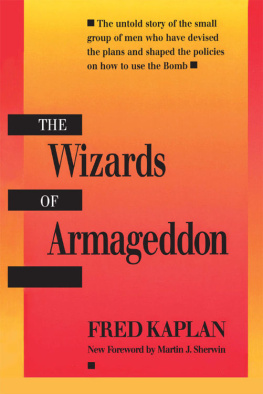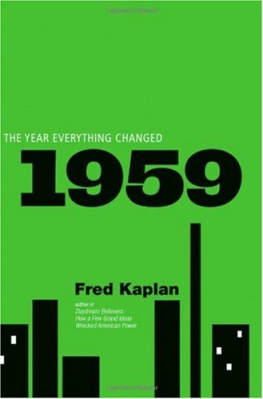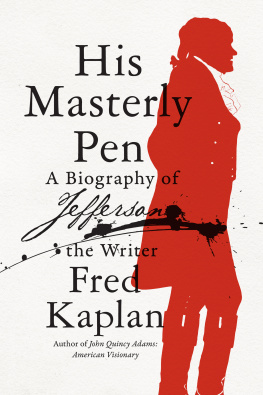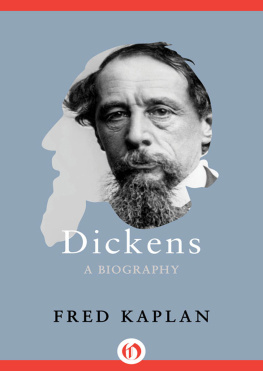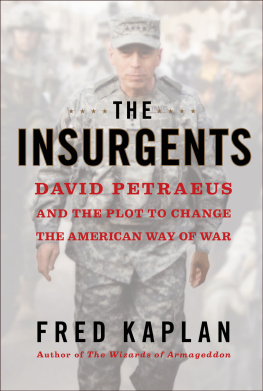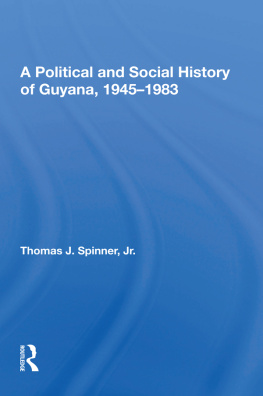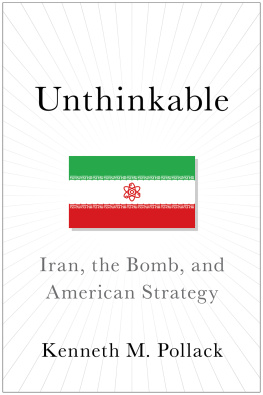Fred Kaplan - The Wizards of Armageddon
Here you can read online Fred Kaplan - The Wizards of Armageddon full text of the book (entire story) in english for free. Download pdf and epub, get meaning, cover and reviews about this ebook. year: 1991, publisher: Stanford University Press, genre: History. Description of the work, (preface) as well as reviews are available. Best literature library LitArk.com created for fans of good reading and offers a wide selection of genres:
Romance novel
Science fiction
Adventure
Detective
Science
History
Home and family
Prose
Art
Politics
Computer
Non-fiction
Religion
Business
Children
Humor
Choose a favorite category and find really read worthwhile books. Enjoy immersion in the world of imagination, feel the emotions of the characters or learn something new for yourself, make an fascinating discovery.
- Book:The Wizards of Armageddon
- Author:
- Publisher:Stanford University Press
- Genre:
- Year:1991
- Rating:3 / 5
- Favourites:Add to favourites
- Your mark:
- 60
- 1
- 2
- 3
- 4
- 5
The Wizards of Armageddon: summary, description and annotation
We offer to read an annotation, description, summary or preface (depends on what the author of the book "The Wizards of Armageddon" wrote himself). If you haven't found the necessary information about the book — write in the comments, we will try to find it.
The Wizards of Armageddon — read online for free the complete book (whole text) full work
Below is the text of the book, divided by pages. System saving the place of the last page read, allows you to conveniently read the book "The Wizards of Armageddon" online for free, without having to search again every time where you left off. Put a bookmark, and you can go to the page where you finished reading at any time.
Font size:
Interval:
Bookmark:
Stanford University Press
Stanford, California
Copyright 1983 by Fred Kaplan
Foreword copyright 1991 by the Board of Trustees of the Leland Stanford Junior University
First published by Simon & Schuster, Inc., in 1983
Reissued by Stanford University Press in 1991
Printed in the United States of America
ISBN 0-8047-1884-9
LC 90-71236
ISBN 978-0-8047-9617-0 (e-book)
THE WIZARDS OF ARMAGEDDON
Fred Kaplan
STANFORD UNIVERSITY PRESS
STANFORD, CALIFORNIA
STANFORD NUCLEAR AGE SERIES
General Editor, Martin Sherwin
ADVISORY BOARD
Barton J. Bernstein,
David Holloway, and
Wolfgang K. H. Panofsky
FOR MY PARENTS
THE STANFORD NUCLEAR AGE SERIES
CONCEIVED BY SCIENTISTS, delivered by the military, and adopted by policymakers, nuclear weapons emerged from the ashes of Hiroshima and Nagasaki to dominate our time. The politics, diplomacy, economy, and culture of the cold war nurtured the nuclear arms race and, in turn, have been altered by it. We have had the bomb on our minds since 1945, E. L. Doctorow observes. It was first our weaponry and then our diplomacy, and now its our economy. How can we suppose that something so monstrously powerful would not, after forty years, compose our identity? The great golem we have made against our enemies is our culture, our bomb cultureits logic, its faith, its vision.
The pervasive, transformative potential of nuclear weapons was foreseen by their creators. When Secretary of War Henry L. Stimson assembled a committee in May 1945 to discuss postwar atomic energy planning, he spoke of the atomic bomb as a revolutionary change in the relations of man to the universe. Believing that it could mean the doom of civilization, he warned President Truman that this weapon has placed a certain moral responsibility upon us which we cannot shirk without very serious responsibility for any disaster to civilization.
In the decades since World War II that responsibility has weighed heavily upon American civilization. Whether or not we have met it is a matter of heated debate. But that we must not fail and, moreover, that we are also responsible for preparing the next generation of leaders to succeed, can hardly be questioned.
Today, nearly half a century into the nuclear age, the pervasive impact of the nuclear arms race has stimulated a fundamental re-evaluation of the role of nuclear armaments and strategic polcies. But mainstream scholarly work in strategic studies has tended to focus on questions related to the development, the deployment, and the diplomacy of nuclear arsenals. Such an exclusively managerial focus cannot probe the universal revolutionary changes about which Stimson spoke, and the need to address these changes is urgent. If the academic community is to contribute imaginatively and helpfully to the increasingly complex problems of the nuclear age, then the base of scholarship and pedagogy in the national security-arms control field must be broadened. It is this goal that the Stanford Nuclear Age Series is intended to support, with paperback reissues of important out-of-print works and original publication of new scholarship in the humanities and social sciences.
Martin J. Sherwin
General Editor
CONTENTS
by Martin J. Sherwin
FOREWORD
Martin J. Sherwin
NEAR THE END of his brilliant and compelling study of the nuclear priesthood and their classified world, Fred Kaplan describes the ambivalence of one of his wizards: In retrospect, [he] saw that once he slipped into the deep, dark pit of nuclear strategy, it was easy to become totally absorbed, living, eating, breathing the stuff every hour of every day, but that once he departed from that realm for a while and scanned it from a distance, it seemed crazy, unreal.
But no matter how clearly the madness of the enterprise appeared from afar, the temptation was irresistable to play this game of the gods, to calibrate and recalibrate the delicate balance of terror. Thus, when the Pentagon summoned he responded as before, and he slipped slowly into the pit once more.
At the center of that pit was the RAND Corporation, the original cold war Think Tank, funded by the Air Force and dedicated to the proposition that all problemsincluding the problem of nuclear warcould be controlled by rational analysis. Established in the late 1940s to think about the unthinkable for the military service that appears to have thought about little else, RANDs defense intellectuals invented a new language and vocabulary and, in the process, taught an entire generation of political and military leaders (Russians no doubt as well as Americans) to view the problems of war and peace in the nuclear age as the economists, political scientists, and physicists at RAND thought about them.
What kind of men will be willing to work in this centrally important field in peacetime, sociologist Edward Shils asked on a conference on atomic energy in September 1945, when they know that all they do is intended for war and that all they can do can confer on mankind only the dubious benefits of a victory in an atomic bomb war?
The Wizards of Armageddon answers Shilss question explicitly, and implicitly poses another: In light of the strategic theories of the past (which Kaplan describes in revealing and terrifying detail), how is it possible to avoid a nuclear holocaust in the future? The answer may be found in the pages of this book, but it is an answer that neither the strategists nor our government are willing to accept.
Ever since the bomb became a reality it has been employed as an instrument of policy and, as Kaplans thorough research demonstrates, the purpose of all strategic thinking has been to maintain it as such. The bizarre theoriesMassive Retaliation, Mutual Assured Destruction (MAD), Counterforce, limited nuclear options, shot across the bow, first strike/second strike, and so onwere not conceived merely as deterrents to war; they were designed as determinants of the peace. As such, they did not have to conform with reality so much as they had to help shape it. All the gasping of horror which occurs every time the use of the atomic bomb is mentioned, Bernard Brodie, the father of nuclear strategy complained during the Korean War, is extremely harmful to us politically and diplomatically. After all, the purpose of the enterprise is to find more reasonable forms of using violence, explained RAND alumnus Herman Kahn, author of On Thermo-nuclear War and Thinking About the Unthinkable.
Trapped between the reality of nuclear weapons and the politics of the cold war, our political leaders have been increasingly attracted to the nuclear option since 1945. As McGeorge Bundy has remarked, Presidents and politburos... may not themselves be persuaded by the refined calculations of the nuclear gamesmanbut they do not find it prudent to expose them for the political irrelevance they are.... In consequence, the internal politics of the strategic arms race has remained the prisoner of its technology.
The fusion of technology and theory in the service of diplomacy led to a structure of peace that teetered precariously on the brink of nuclear disaster. In the 1980s, the first Reagan administrations discussions of limited and protracted nuclear war, its emphasis on first-strike weapons, and its concern with civil defense brought this reality to public attention. But the bellicose language also created an erroneous impression: that these attitudes and nuclear war theories were something new. As Kaplans inside history of nuclear strategy demonstrates, it was only the public articulation of these views that was newthese attitudes and theories had determined policies for decades. By unintentionally precipitating the nuclear debate of the 1980s, the Reagan administration helped to draw attention to the nuclear strategists deep, dark pit. But even though Gorbachev pointed searchlights of sanity into the pit, it is still not possible to see its contents clearly.
Next pageFont size:
Interval:
Bookmark:
Similar books «The Wizards of Armageddon»
Look at similar books to The Wizards of Armageddon. We have selected literature similar in name and meaning in the hope of providing readers with more options to find new, interesting, not yet read works.
Discussion, reviews of the book The Wizards of Armageddon and just readers' own opinions. Leave your comments, write what you think about the work, its meaning or the main characters. Specify what exactly you liked and what you didn't like, and why you think so.

